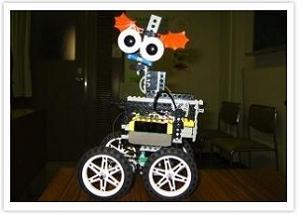Advanced Lectures on Architecture for Information Media Space
| Lecturer | Katashi NAGAO, Professor |
|---|---|
| Department | Graduate School of Information Science, 2011 Fall |
| Recommended for: | Information science graduates (2・1.5 hours / session 1 session / week 15 weeks / semester) |

Course Overview
In this course, we will learn about the hardware and software associated with media contents and robots. Using LEGO 'Mindstorms' robots, we'll also study robot mechanism (motors, sensors, etc,) and their programming.
Key Features
To promote active participation in this class, the course offers many opportunities for students to think for themselves, and put their ideas to practice.
To be more specific, the backbone of this course is the LEGO robot 'Mindstorms'. With 'Mindstorms', we can create a robot with three main components (sensors, motors, and a controller), and, through Java programming language create a program to actually move the robot. By assigning various tasks for the robot to perform, in addition to making the course itself a kind of contest, one can effectively reflect on what he or she has learnt, while also making evaluation of their achievements easier to understand.
In the lessons, only the simplest, most basic programs were already at the students' disposal. This provides plenty of chances in which students can put their newly learned programs to work, without referring to other materials. Programming the robot –entering the rules and commands that allow the robot to move on its own- is no special feat, requiring no more than some trial-and-error to acquire basic programming skills. Therefore, even after this course, the programs students have learned can be put to uses other than robots as well.
In this way, besides the ordinary skills for programming, students can also acquire specialized knowledge on the mechanism and programming of autonomous robots.
Students Accomplishments
Course Characteristics
In this course, instructor and students together can evaluate their progress through the clear task of a 'robot contest'. Since the programming environment of this course uses a commonplace language (Java) and environment, students can use the skills attained in this course in their future research and careers.
Course Contents
- Practical studies using LEGO 'Mindstorms'
Using actual objects for study will assist in improving students' skills as designers.
Programming practice with Java language
We aim to understand the basic definitions of the contents and their usage.
Basics and practice of agents and robots
We'll study the building methods and adaptations of autonomous systems, specifically the interaction between the physical environment, humans, and systems.
Course Requirements
The following conditions are needed to fully enjoy this class.
- A basic knowledge of Java programming language
- A notebook PC
- An interest in robots and AI (Artificial Intelligence)
- An experience with LEGO toys in childhood
- A willingness to cooperate with others
Capacity
Around 15 members
Textbooks
None specified
Related Resources
Sample programs
Links
The following pages are linked to the World Wide Web and are not under the management of Nagoya University OCW. For further information, please contact each site.
Assignments
Students are to file a paper on how they contributed to creating the group's robot. Contents to be noted:
- the structural characteristics of the robot
- improvements made to the software
- overall contribution of each member in the groupwork (note percentage as well)
- comments regarding the course, questions, etc.
Course Schedule
| Session | Contents |
|---|---|
| 1 | Overall Introduction |
| 2 |
Getting the Robot to Move
|
| 3 |
Giving the Robot Tasks
|
| 4 |
Groupwork (1)
|
| 5 |
Groupwork (2) |
| 6 |
Robots and Contents (1)
|
| 7 |
Robots and Contents (2)
|
| 8 |
Groupwork (3)
|
| 9 |
Groupwork (4)
|
| 10 |
Robot-Human Interaction
|
| 11-13 |
Groupwork (5)
|
| 14 |
Pre-contest Matchup
|
| 15 |
Robot Contest
|
Lecture Handouts
Note: All files are in Japanese.
Projector documents
Session 1
Grading
Grading will be based on the performance of the group (mainly the results of the robot contest) and the students' contribution to the groupwork.
- Each group will be given points according to the results of the contest.
- The contribution of each member to his/her group will be asessed (in %).
- Students' score is the group score multiplied by personal contribution(%) (shown on a 0-100 scale).
Last updated
May 10, 2020
